
Medtech leaders prioritize technology and consumers Findings from a new survey and analysis of earnings calls in the first half of 2020
11 minute read
23 July 2020
Medtech companies consider technology key to success in today’s markets, but they also rate this area as their top challenge. To bridge this gap, they need to integrate features that enable digital well-being and virtual health into their products.
Executive summary
Medtech companies are continuously working toward bringing innovative and breakthrough products to global markets. In our survey, we expected senior executives to highlight innovation as a major strategic focus and we found this held true—innovation, fueled by technology, is important today and will assume even greater importance in the future. When we asked about new types of offerings, responses revealed some gaps between how important some of the new technologies will be and how well-prepared companies said they felt to drive impact. To be successful in future, medtech companies should integrate features in their offerings, including digital well-being, virtual care, and remote monitoring. They should also invest in technology to transform their businesses and become more efficient and effective in the market.
Learn more
Explore the life sciences collection
Learn about Deloitte's services
Go straight to smart. Get the Deloitte Insights app
COVID-19 has affected multiple aspects of medical technology—on the positive side, it has created demand for rapid and accurate tests and an adequate supply of personal protective equipment. The shift of some health care to virtual is an exciting opportunity. However, delayed nonurgent care has created some headwinds for the industry, and the broader economic, trade, and supply chain issues accompanying the pandemic may be felt for some time.
This article provides insights from two sources: a survey we fielded in March and April 2020, during the COVID-19 pandemic, and text analysis of 42 medtech companies’ quarterly earnings statements in the last quarter of 2019 and first quarter of 2020 (for details, see sidebar, “Methodology”).
Our survey found that:
- A huge majority (88%) of respondents rated advances in technology as a top challenge, followed by policy and regulatory activity, and changes in consumer attitudes, behaviors, and spending (63%).
- Half (50%) of the executives rated transformation of functions using digital and information technologies, cyber readiness, and economic issues as their highest priorities. Looking ahead, 69% of them said cyber readiness will be their highest priority in the next five years—signaling the need to balance digital transformation opportunities with risk preparedness. Half or more of respondents also flagged transformation of functions using digital and information technologies (56%), and economic issues (50%) as areas of focus.
- Executives think they are most prepared to address emerging opportunities around customized treatments (81%), curative therapies (69%), and digital therapeutics (63%); only 38% said they are prepared for developments in nonpharmacological interventions—nontraditional technologies such as robotics, nanotechnology, or tissue engineering.
- Even though leveraging digital technologies is an important strategic priority, none of the companies rated themselves as digitally mature.
As economies and the health care industry start to recover, investments into emerging technologies (such as robotics, AR/VR) will likely gain even greater prominence—both in Medtech products and in transforming aspects of the business. The future of health (especially virtual care) and the future of work (especially virtual work) are likely to arrive sooner than we would have predicted even last year.
Methodology
Between March and April 2020, the Deloitte Center for Health Solutions surveyed medtech company leaders to understand their strategic priorities and the risks and challenges the industry faces. Respondents to the survey included individuals in the following roles: chief executive officer (CEO), chief operating officer (COO), chief commercial officer (CCO), and EVPs/VPs of business/corporate development of 16 medtech companies.
In addition, we analyzed quarterly earnings statements from 39 of the largest medtech companies. The analysis was based on relevance analysis of keyword/ontology employing natural language processing to determine which themes/issues the industry thinks could have an impact on operations in the current environment.
Advances in technology, the top issue facing medtech
Close to 90% of respondents rated advances in technology as the top issue. This makes sense given that medtech companies are in the business of technology as a product offering, but also may be seeing opportunities to transform aspects of their business with digital investments.
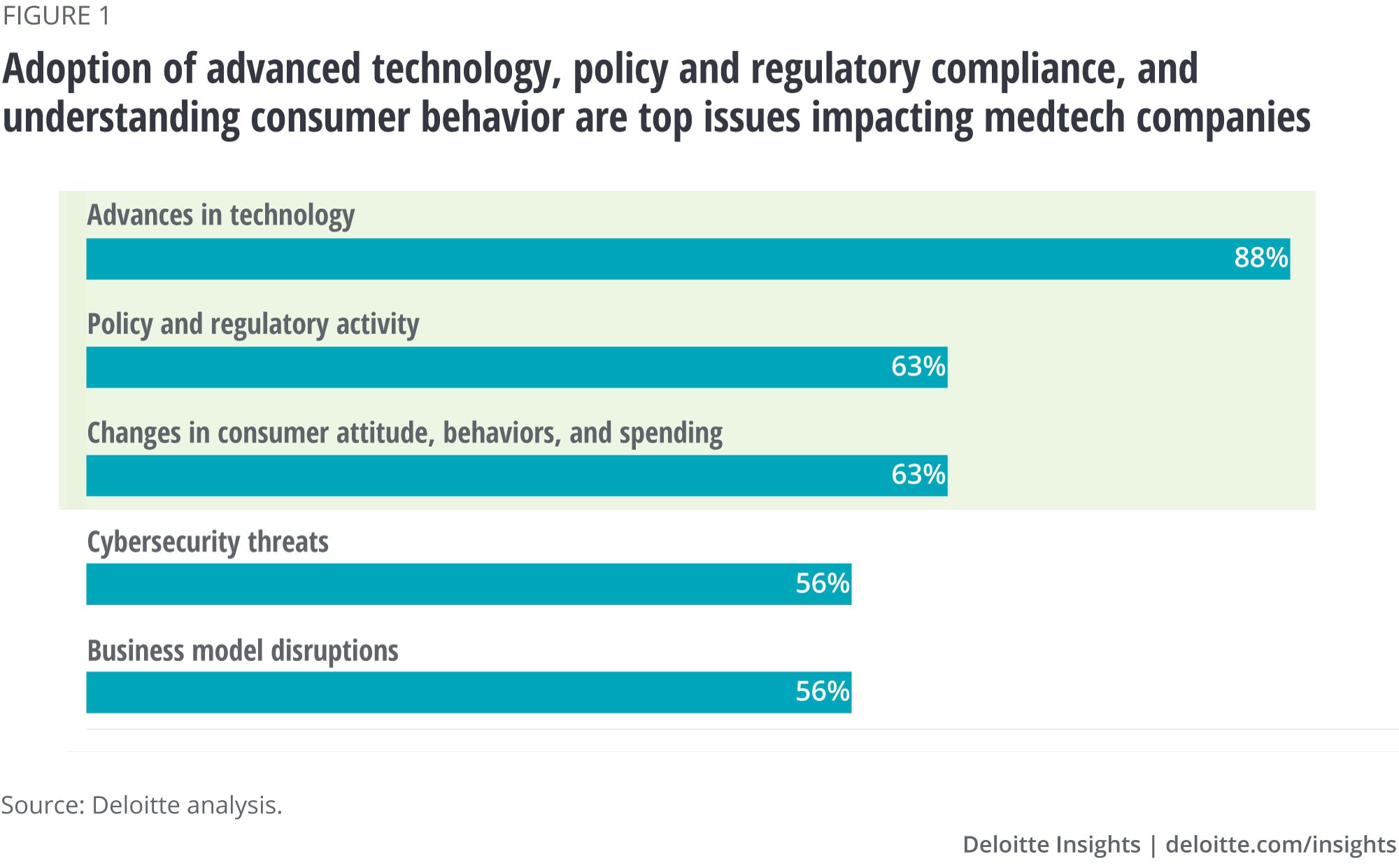
The next most common issues cited were changing consumer attitudes and spending behavior and policy and regulatory issues (63%). Respondents rated policies affecting supply chain, privacy and data security, and tax as equally important. Policy and regulatory changes can create new opportunities —for example new payment models in Medicare—but they can also slow down innovation or make compliance more costly.1
More than half of the respondents cited cyber and business model disruptions as top issues. A focus on innovation may call for different approaches to payment, partnerships, and commercial models, which is consistent with what we found in a recent report, Winning in the future of medtech.2 In the future, medtech companies are likely to change dramatically. The scope for collaborations and partnerships to address consumers’ demands is likely to increase. One approach that medtech companies can consider is partnering with consumer technology companies, which can help them develop offerings that keep people well (e.g. for devices for tracking biometric information) and demonstrate value to purchasers.
Cyber and digital transformation of functions rise in list of priorities
When we asked respondents to rank their current strategic priorities, they chose cyber and transformation of functions using digital. Cyber rises from a top strategic priority for 50% of companies right now to a top priority for 69% in five years. Respondents also expect R&D, global markets, and policy and regulatory to be more important priorities in five years than they are today.
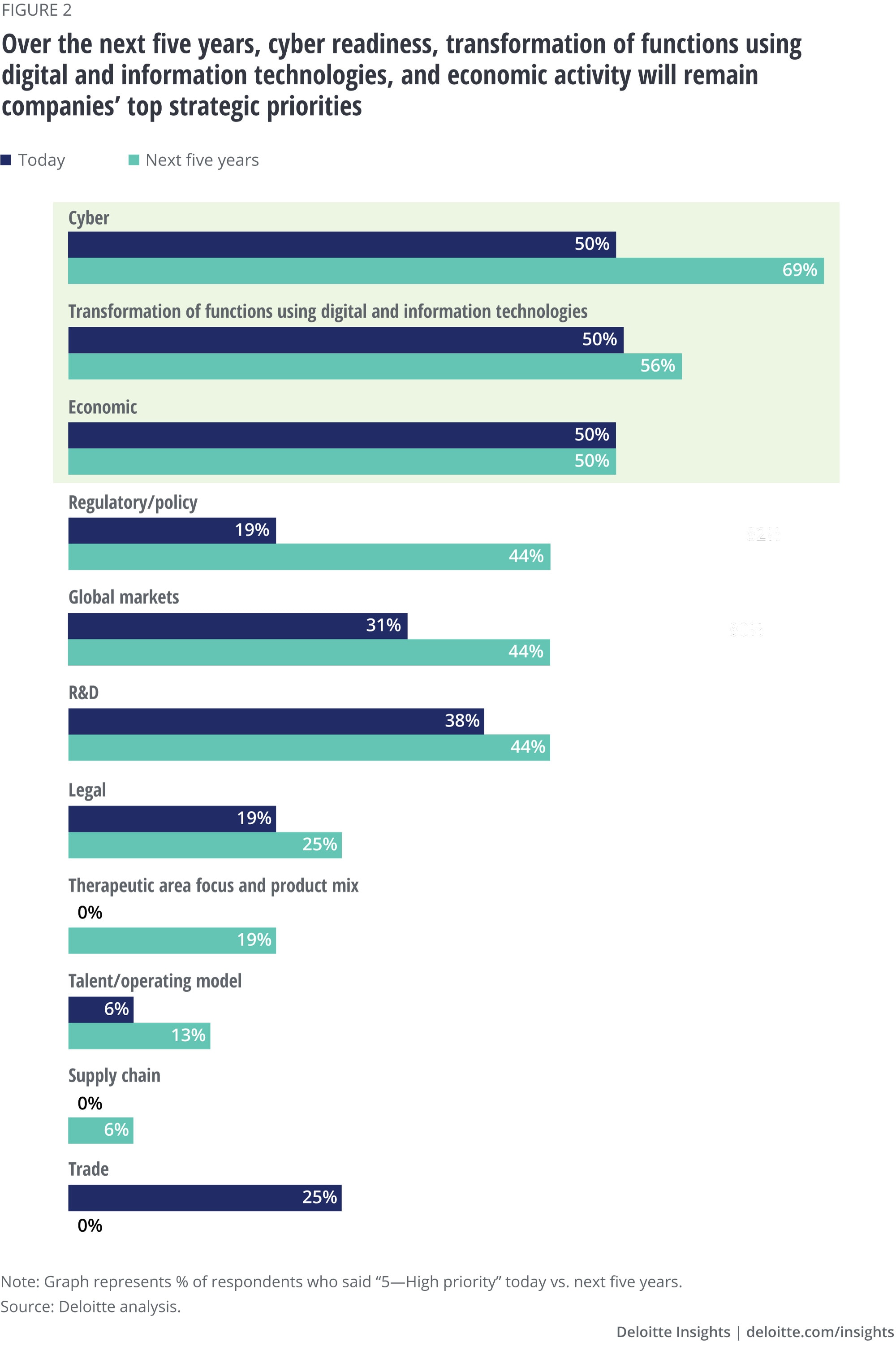
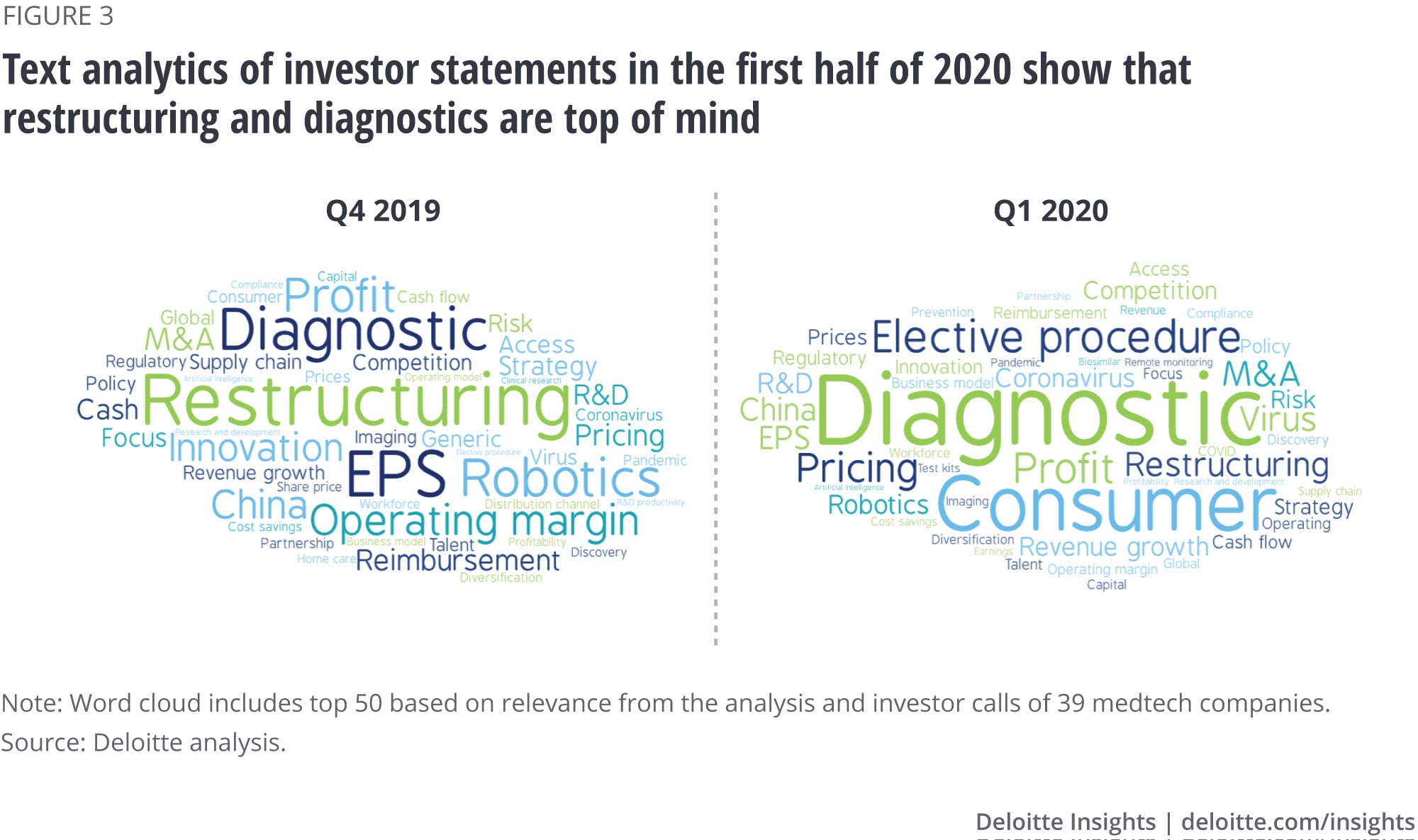
Our analysis of the text analysis of investor meeting transcripts in the last quarter of 2019 and first quarter of 2020 showed a strong focus in both the periods on diagnostics as an area of strategic focus. Between the two periods, the words “consumer” and “elective procedures” gained salience—likely reflecting the COVID-19 pandemic. The words “restructuring” and “earnings per share” declined in prominence between the two periods.
The research from text analytics points to an increased focus toward emerging and novel technologies, new business models, and the economic impact companies are faced with due to the pandemic. This is consistent with our survey findings.
How do medtech companies expect future of health developments to impact their business?
For medtech companies, as their survey responses and the text analytics show, the key to future growth will likely be understanding consumers’ needs, harnessing data, keeping people well, and taking advantages of insights and innovation coming from new technologies. Companies can win in the new health economy if they offer high value products and services—not only those that have the latest technology and clinical impact, but also that can be positioned to improve total cost of care.3 These perspectives are all consistent with our vision for the future of health.
Our survey asked respondents to consider five statements that align with our future of health perspective for life sciences companies—some of which are threats to pharma companies and opportunities for medical technology companies. We asked about:
- Curative therapies where companies assess new treatment regimen and develop a better understanding of cure. For this, companies may need to adopt different business models.
- Nonpharmacological interventions that include adoption of sophisticated and nontraditional medical technologies. This could bring precise medical intervention enabled by robotics, nanotechnology, or tissue engineering.
- Prevention and early detection to reduce prevalence of certain diseases by advancements in new technologies, and help consumers with early detection.
- Customized treatments that include personalized treatments, utilizing patient data to provide custom solutions.
- Digital therapeutics that could help advance transition to more care outside the hospital setting.
Survey respondents rated nonpharmacological interventions (94%) and curative therapies and customized treatments (75%) as most impactful.
Are they prepared to develop solutions and adapt to these changes? Medtech leaders rated their companies as well prepared to deal with growing demand for customized treatments, curative therapies, and digital therapeutics. The biggest gap between impact and preparedness was for nonpharmacological intervention (only 38% felt they were well prepared; a 56% difference in impact versus preparedness).
Digital therapeutics is gaining traction with a shift in focus from treatment to prevention and higher use of real-time data for greater patient control. As the health sector transitions from a focus on acute intervention to one centered around prevention and wellness, these technologies will likely evolve. There is an increase in focus on technologies that track real-time data, and investment in artificial intelligence–based wellness coaching that could help enable behavior change, avoiding the need for surgery or hospitalization altogether.4
Companies are investing in digital capabilities, but none rate themselves as digitally mature
Opportunities for digital transformation are available throughout medtech companies’ business, from business operations such as production and enabling functions to engagement with patients, physicians, health systems, and payers to developing new products and services. Realizing each opportunity can require the capabilities of a digitally maturing organization, including an overall strategy, culture of collaboration and experimentation, and supportive leadership. Digitally maturing companies differ from those in the earlier stages of digital maturity in the way they apply digital, scale learnings, collaborate, and facilitate change. 5
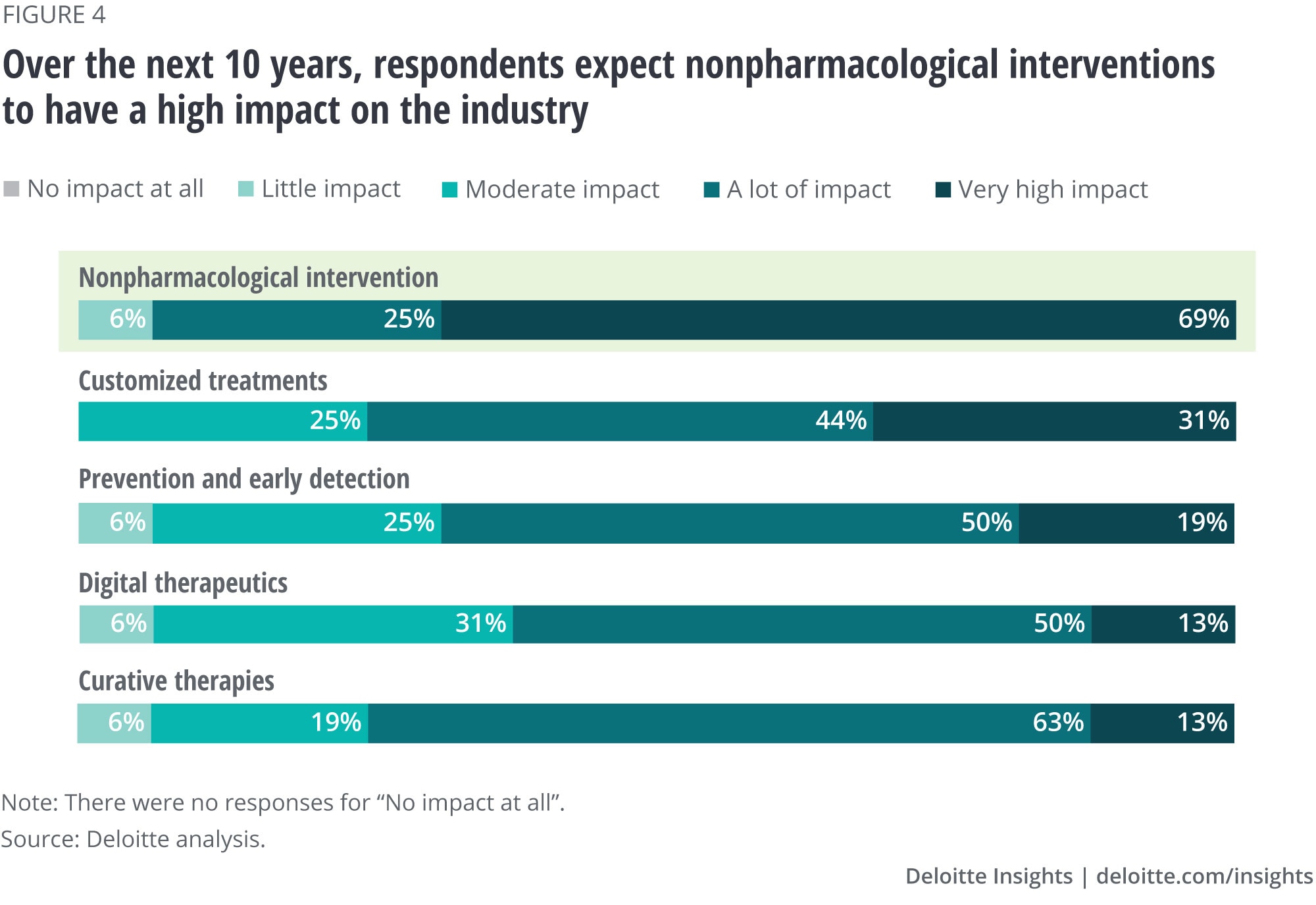
Companies believe that transforming functions using digital technologies will be of high strategic priority in the next five years. Less than half of the medtech companies responded that they are using digital technologies and capabilities to improve processes (44%). Surveyed medtech leaders reported that the key objectives for their digital investments are to reduce costs (31%), gain insights into execution of business strategy (25%), and increase demand for products (25%).
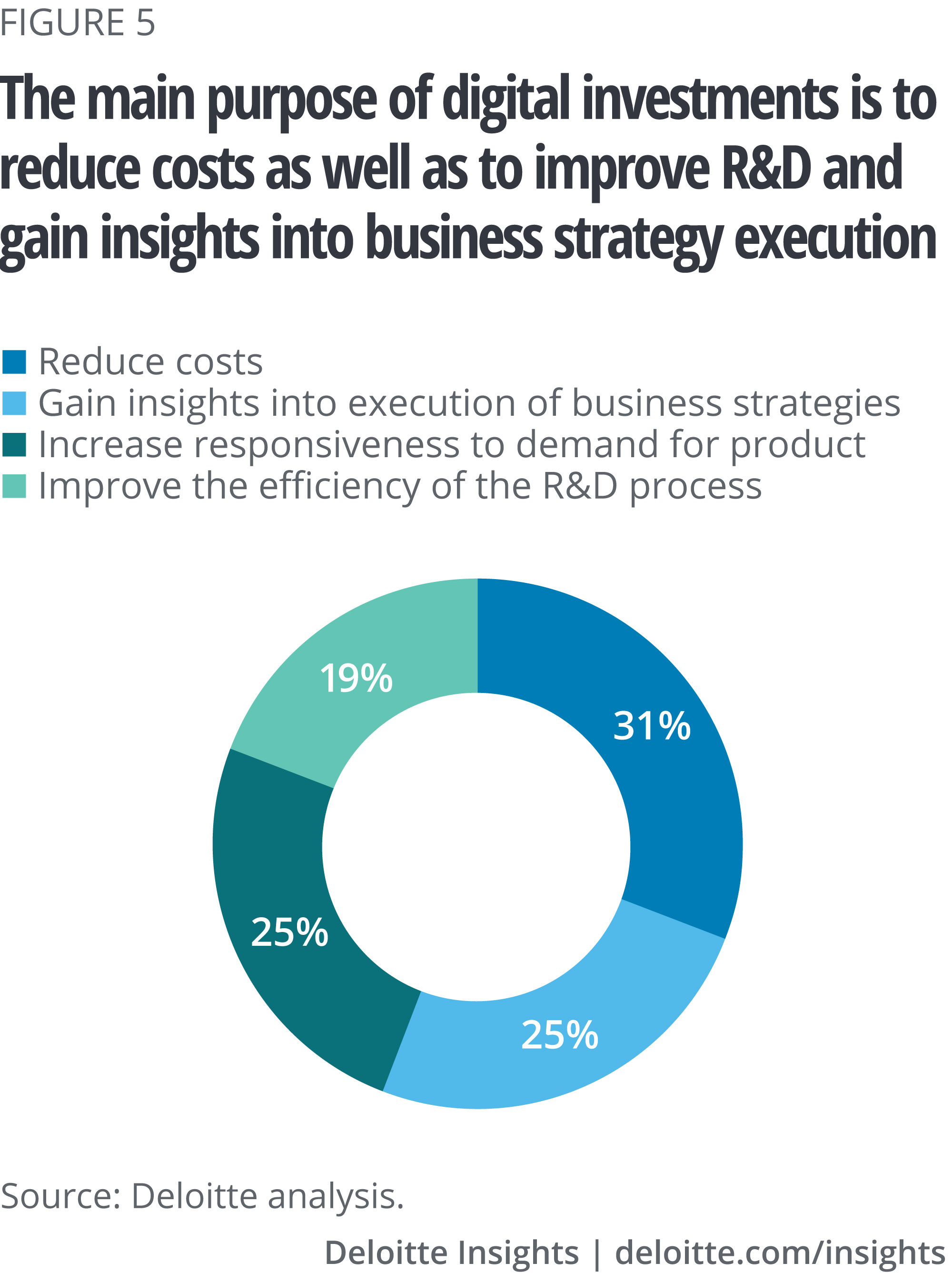
Digital investment can help companies have a cost-effective and optimized way of executing business strategies. Going digital can help companies deal with rapidly changing technologies and improve the research and development process by strengthening the pipeline.
Long-term goals and the COVID-19 impact: How can companies reboot and recover?
In unstructured comments to the survey, executives flagged economic challenges arising from COVID-19 that may impact their long-term goals. The pandemic has created headwinds around reduced volume of services due to postponement of nonurgent care, and created some supply chain issues. They also mentioned general economic issues as an area of concern.
Some of the comments they made include:
- “COVID-19 will be a major reason to slow down growth this year.” —EVP, medtech company
- “The first challenge is the outbreak of coronavirus all over the globe. Secondly, it is mainly about the old school vs. the new technologies that are coming up that pose a challenge. And the final challenge we see is how to map demand with supply.” —EVP, medtech company
- “Poor analysis of future requirements for our investment. Coping with changing procedures due to COVID-19.” —COO, medtech company
Implications
Embrace the future of health. Many in the medtech industry are steering toward digital adoption, technological transformation, changing consumer attitudes, and business model disruptions. To achieve this, companies should consider new capabilities to win in the future of health. Being prepared with consumer-centric product portfolios, and an operating and business model that supports this, can be key to companies. Medtech companies should also consider building platforms to make sense of all the available data. Companies should also see the need to forge partnerships with hospitals to collect data on unmet needs to build nonpharmacological interventions. Medtech companies should consider what role they would like to play in the future ecosystem: data and platform provider, well-being and care delivery organization, care enabler, or elements of all three. This change in strategic focus may require leaders to identify their company’s relative strength, revisit their business strategy to cater to changing consumer demand, and identify ways to fill the gaps.
Define strategic goals in the context of new entrants, business models, and opportunities. Medtech companies are facing new competitive threats. Their strategies should answer fundamental questions of whether or not companies want to be product or solution companies; this then leads to questions about whether they want to be in the hardware or software business moving forward. Once they decide this, they should figure out where they will get the capabilities (partnerships) and what the business model (payment) might look like. Companies are forming traditional partnerships that have focused on hardware development and partnering with consumer technology companies to be able to work on software/platforms as well.
Virtual may be a way to go. One feature of COVID-19 has been the rapid adoption by consumers and physicians of virtual care. One might expect sustained interest in virtual care, home care, and remote monitoring services. Medtech companies might want to invest in remote monitoring solutions to improve remote access to patients, to help enable the transition to more care outside of the hospital and shift the emphasis toward prevention and maintaining well-being.
Consider digital investments to save money, gain insight into business operations, and accelerate competitive opportunities. Medtech companies can benefit greatly by digitization—scenarios such as a network of devices, machines, and other items embedded with sensors enable interconnectivity and exchange of data—and can help connect manufacturers with suppliers. Logistics and distribution are also benefitted in avoiding costs of physical product damages, deterioration during distribution, and consequences faced due to widespread counterfeiting in the market.6
Prepare for and address, especially cyber and economic risks, but also policy and regulatory risks. With increased digitization, medtech companies should be prepared to handle and mitigate cyber risks. The growth of connected medical devices renders medical devices to be susceptible to cybersecurity attacks. In addition, companies should stay prepared for change in any laws and regulations that could potentially lead to losses to business.
© 2021. See Terms of Use for more information.
Learn more about medtech in life sciences
-
New payment models in medtech Article5 years ago
-
Radical interoperability Video5 years ago
-
Winning in the future of medtech Article5 years ago
-
Tackling digital transformation in life sciences Article5 years ago
-
Life Sciences Collection











